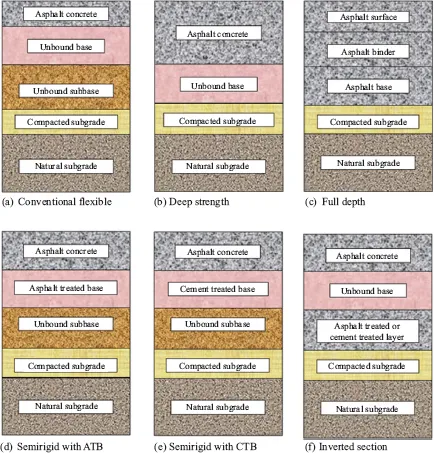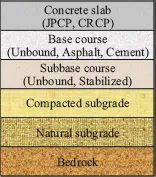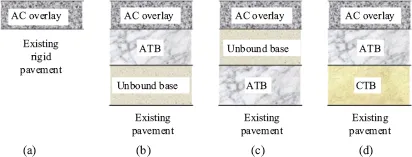
- 110 pages
- English
- ePUB (mobile friendly)
- Available on iOS & Android
eBook - ePub
Geotechnical Aspects of Pavement Engineering
About this book
Familiarity with geotechnical aspects of pavement engineering is essential for the practicing pavement engineer. When designing pavements, accurate characterization of the existing subgrade condition becomes a crucial task. In the past, traditional geotechnical exploration and testing methods have been used to characterize existing subgrade conditions. However, with the introduction of the Mechanistic-Empirical (ME) pavement design, there is a need for improved and more appropriate methods of subgrade characterization, for prediction of future pavement conditions with better accuracy. Hence, this handbook will present a useful tool for practicing pavement engineers.
Frequently asked questions
Yes, you can cancel anytime from the Subscription tab in your account settings on the Perlego website. Your subscription will stay active until the end of your current billing period. Learn how to cancel your subscription.
No, books cannot be downloaded as external files, such as PDFs, for use outside of Perlego. However, you can download books within the Perlego app for offline reading on mobile or tablet. Learn more here.
Perlego offers two plans: Essential and Complete
- Essential is ideal for learners and professionals who enjoy exploring a wide range of subjects. Access the Essential Library with 800,000+ trusted titles and best-sellers across business, personal growth, and the humanities. Includes unlimited reading time and Standard Read Aloud voice.
- Complete: Perfect for advanced learners and researchers needing full, unrestricted access. Unlock 1.4M+ books across hundreds of subjects, including academic and specialized titles. The Complete Plan also includes advanced features like Premium Read Aloud and Research Assistant.
We are an online textbook subscription service, where you can get access to an entire online library for less than the price of a single book per month. With over 1 million books across 1000+ topics, we’ve got you covered! Learn more here.
Look out for the read-aloud symbol on your next book to see if you can listen to it. The read-aloud tool reads text aloud for you, highlighting the text as it is being read. You can pause it, speed it up and slow it down. Learn more here.
Yes! You can use the Perlego app on both iOS or Android devices to read anytime, anywhere — even offline. Perfect for commutes or when you’re on the go.
Please note we cannot support devices running on iOS 13 and Android 7 or earlier. Learn more about using the app.
Please note we cannot support devices running on iOS 13 and Android 7 or earlier. Learn more about using the app.
Yes, you can access Geotechnical Aspects of Pavement Engineering by Nishantha Bandara, Manjriker Gunaratne in PDF and/or ePUB format, as well as other popular books in Tecnología e ingeniería & Ingeniería civil. We have over one million books available in our catalogue for you to explore.
Information
CHAPTER 1
INTRODUCTION TO PAVEMENT ENGINEERING
With the introduction of the Mechanistic-Empirical Pavement Design (MEPD) procedures, an emphasis on collecting reliable material property data has been seen in the recent past. This is due to the fact that, when properly calibrated performance models are used by specifying accurate material inputs, realistic pavement performance predictions can be obtained from the MEPD procedures. The majority of materials used above the subgrade of a pavement structure are engineered in nature, and hence they could be produced to specifications and tested for accurate material properties. However, in situ subgrade materials show considerable variability from point to point in terms of its engineering properties. Therefore, accurate and easy-to-use methods to characterize pavement subgrade properties have been gaining popularity in the recent past.
Geotechnical aspects of pavement engineering are different from traditional geotechnical engineering due to the marked differences in loading mechanisms associated with highway pavements. Traditional geotechnical engineering generally deals with static, concentrated, or distributed, large-magnitude loading conditions, while pavement structures mostly deal with fast-moving and dynamic loading situations. Furthermore, effects of environmental and climatic conditions play a major role in pavement structures due to their proximity and the constant exposure to the atmosphere.
The objective of this introductory chapter is to provide an overview to the subject matter covered in the book. The components of a pavement system, types of pavement, and the historical evolution of design are briefly introduced in the following sections.
1.1 THE PAVEMENT SYSTEM
The pavement system consists of distinct layers of materials placed on the subgrade, including select materials, subbase, base, and a surface course, as shown in Figure 1.1. The subgrade of the pavement system includes natural ground prepared either by mechanically compacting, stabilizing, or building with select borrow fill materials to create a platform for the construction of upper pavement layers. However, as the subgrade acts as the foundation for the entire pavement structure, proper evaluation of the subgrade materials and close supervision of its construction is important for future pavement performance. Important parameters other than the stiffness of the subgrade material include depth to bedrock or hard layers and seasonal fluctuation of the ground water table.
Pavement subbases generally consist of free draining granular materials. Water seeping through cracks and joints on the pavement surface will penetrate to the subbase through the base course. Granular material in the subbase layer is expected to remove this infiltrated water rapidly to underdrains or roadside ditches. Removal of water from the base and subbase is essential for the durability of pavements. The pavement structures will be weakened by any water retained within base and subbase and lead to premature failure. Furthermore, in areas with cold weather, water retained within the base and subbase can freeze during winter months and heave the pavement structure. During the ensuing spring time, due to the melting of ice within the base or subbase, voids open up under the pavement structure. In addition, the subbase works as a protecting layer for frost-susceptible subgrade material in cold weather areas.

Figure 1.1. Components of a pavement system (NCHRP 2004).
Pavement bases generally consist of freely drainable crushed aggregates, crushed rocks, gravel, slag, crushed concrete, and so on. Typically, better materials are used for the base layer than the subbase. Also, material specification for the base layer is more stringent than for the materials for subbase layer. For flexible pavements, the base layer provides the majority of the structural support, while for rigid pavements, it provides the stiffness needed by the foundation. The base layer also facilitates water drainage from the pavement structure and also protects the frost-susceptible subgrade during winter months in colder climate areas.
The pavement surface course is designed to withstand the impact of traffic loads during the design life of the pavement and provide a smooth ride for the traveling public while assuring adequate skid resistance for safe travel at all times. Pavement surface courses can be made out of one or more layers of asphaltic materials for flexible pavements and Portland cement concrete for rigid pavements. Most of the major highways built with flexible pavements are constructed with hot-mix asphalt (HMA) materials. HMA generally consists of asphalt binder, coarse aggregate, fine aggregate, and other additives mixed at a higher temperature in an asphalt plant. These materials are transported to the project site and laid at higher temperatures. Some low-volume roads are constructed with asphalt emulsion mixed with aggregates at the ambient temperature. Rigid pavements are constructed with Portland cement concrete (PCC) with or without steel reinforcements. If no steel reinforcements are used, they generally consist of joints at regular intervals and are called jointed plain concrete pavements (JPCP). Reinforced concrete pavements can be categorized into two types, jointed reinforced concrete pavements (JRCP) and continuously reinforced concrete pavements (CRCP). As the names suggest, JRCP has joints at regular intervals, and CRCP only contains construction joints. Some very low-volume roads can be constructed with compacted aggregate, gravel, or soil, and they are known as unpaved roads.
Geotechnical components of pavement systems consist of natural subgrade, compacted or stabilized layer of subgrade, subbase, base and aggregate or gravel, or compacted soil in surface layers. Characterization of these materials, their engineering properties, and specific design and construction details for these components are given in the ensuing chapters of this book.
1.2 TYPICAL PAVEMENT TYPES
Pavements are generally categorized by the surface type. There are four different types, accordingly, as listed next:

Figure 1.2. Typical flexible pavements types (NCHRP 2004).
1. Flexible pavements: The surface layer consists of asphaltic materials with no underlying concrete slabs. Typical types of flexible pavements are shown in Figure 1.2.
2. Rigid pavements: The surface layers consist of PCC slabs, which act as the main load-bearing layer. Typical section of a rigid pavement is shown in Figure 1.3.
3. Composite pavements: This category mainly consists of an asphalt surface overlay on a PCC slab. However, more recently, PCC overlays on asphalt pavements have become commonplace. Generally, these types of pavements—overlaying asphalt on old concrete slabs or constructing concrete pavement over old asphalt pavements—are constructed as parts of pavement rehabilitation projects. Typical types of composite pavements are shown in Figure 1.4.
4. Unpaved roads: As the name suggests, these roads are not generally paved and used only for very low-traffic situations. It should be noted that approximately half of the roads in the United States are unpaved. Sometimes, seal coats are used in unpaved roads for dust control or protection of the base or subbase from erosion.

Figure 1.3. Typical rigid pavement section (NCHRP 2004).

Figure 1.4. Typical composite pavement types (NCHRP 2004).
1.3 HISTORY OF PAVEMENT DESIGN
The history of engineered road building dates back to Mesopotamian Civilization (current day Iraq) where they built many miles of stone paved roads around 4000 BC. The first known design method for pavements was known as the Macadam method after its inventor, Mr. McAdam. This method uses broken stones of many sizes placed in symmetrical patterns along the road. This design further expanded to building roads with bitumen (tar) used as a binding agent in the top layer. These designs were known as tarmacadam designs, and one of the first tarred roads was constructed in Paris. The famous Champs-Elysees in Paris was covered in asphalt in 1824, becoming the first modern road in Europe. Asphalt roads came to America in late 1800s, and one of the first roads built with asphalt was Pennsylvania Avenue in Washington, DC.
The following section provides brief descriptions of modern-day pavement design methods.
1.3.1 CALIFORNIA BEARING RATIO (CBR) PAVEMENT DESIGN METHOD
The first known empirical pavement design method is based on the California Bearing Ratio (CBR) develope...
Table of contents
- Cover
- Half-title Page
- Title Page
- Copyright
- Contents
- List of Figures
- List of Tables
- 1 Introduction to Pavement Engineering
- 2 Geotechnical Input in Pavement Design
- 3 Geotechnical Exploration, Testing, and Subgrade Characterization
- 4 Subgrade Conditions Requiring Special Designs
- 5 Construction Specifications, Quality Control, and Quality Assurance
- Bibliography
- About the Authors
- Index
- Backcover